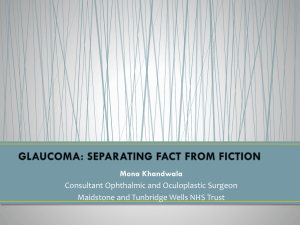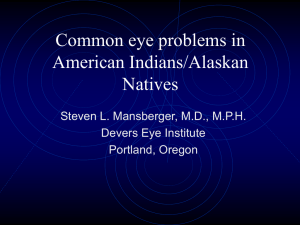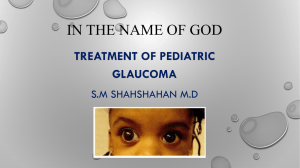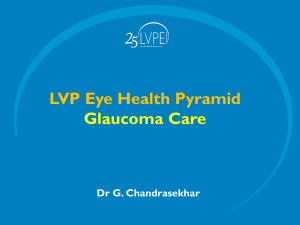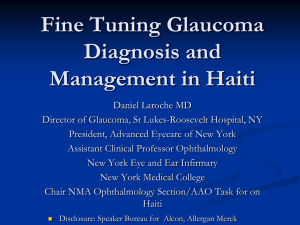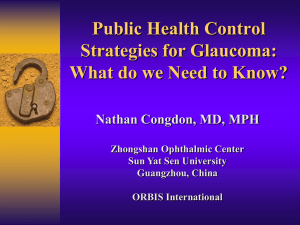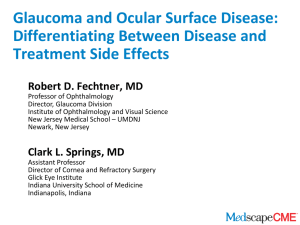Secondary Glaucomas - Medical Council of Guyana
advertisement
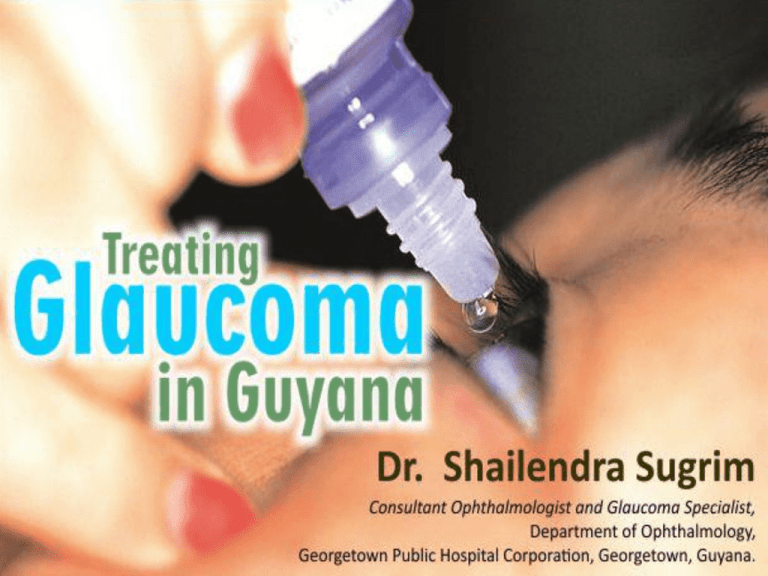
Introduction Based on empirical data and also from studies from individual countries in the Caribbean, primary open angle glaucoma (POAG) is the most common form of glaucoma in the Caribbean region. Studies of black West Indian populations in St. Lucia and Barbados show a prevalence of 8.8% and 6.6%, respectively.1,2 It is the most common form of glaucoma in the US (approx . 1.86% in adults over 40 years).3 1. Mason RP,et al. National survey of the prevalence and risk factors of glaucoma in St. Lucia, West Indies. Part I. Ophthalmology. 1989 Sep;96(9):1363-8. 2. Leske MC, et al. The Barbados Eye Study. Prevalence of open angle glaucoma. Arch Ophthalmol. 1994 Jun;112(6):821-9. 3. Friedman DS, et al; Prevalence of open-angle glaucoma among adults in the United States. Arch Ophthalmol. 2004 Apr;122(4):532-8. Most literature contend that POAG varies significantly according to race and ethnicity. In Caucasians > 40 years in the US, the prevalence is 1.69%.3 The Baltimore Eye Study concluded that OAG is three times more prevalent among African Americans in the United States than among Caucasians.4 In the Latino population in the US prevalence ranges from 1.97%5 and 4.89%6,7 in Latino adults over the age of 40.5 Studies in other ethnic groups show a higher prevalence. 3. Friedman DS, et al; Prevalence of open-angle glaucoma among adults in the United States. Arch Ophthalmol. 2004 Apr;122(4):532-8. 4. Tielsch JM, Sommer A, Katz J. Racial variations in the prevalence of openangle glaucoma. The Baltimore eye survey. JAMA 1991; 266:369 – 74. 5. Quigley HA, et al. The prevalence of glaucoma in a population-based study of Hispanic subjects. Arch Ophthalmol. 2001 Dec;119(12):1819-26. 6. Varma R, et al; Los Angeles Latino Eye Study Group. Prevalence of OAG and ocular hypertension in Latinos. Ophthalmology. 2004 Aug;111(8):1439-48. 7. Kim E, Varma R. Glaucoma in Latinos/Hispanics. Curr Opin Ophthalmol. 2010 Mar;21(2):100-5. American Indian/Alaskan Native populations also show a large percentage of normal-tension glaucoma with a 6.2% prevalence of OAG, 100% of which had normal eye pressures.10 It is accepted that people of Asian descent are much more likely to suffer from angle closure glaucoma (ACG), while those of African or European origin are more likely to develop POAG. Despite this, population based studies in India report prevalences of POAG between 2 to 13%.* *(Vellore Eye Survey, Andhra Pradesh Eye Disease Study, Aravind Comprehensive Eye Survey, Chennai Glaucoma Study and West Bengal Glaucoma Study). Primary open angle glaucoma is estimated to affect 6.48 million persons whilst primary angle-closure glaucoma is estimated at 2.54 million. Most of those with disease are undetected and major challenges exist in detecting and treating those with disease. In addition, the Ocular Hypertension Treatment Study (OHTS) showed that black race was a risk factor for conversion from ocular hypertension to OAG.10 However, it also showed that corneal thickness and cup-to-disc ratio may present a better means of evaluating risk factors than race. 10. Sommer A, Tielsch JM, Katz J et al. Racial differences in the cause-specific prevalence of blindness in East Baltimore. NEJM 1991; 325:1412-1417. Brief Review of Glaucoma – Key Points Brief Review of Glaucoma – Key Points Brief Review of Glaucoma – Key Points • Glaucoma - Characteristic visual loss from optic neuropathy - Open angle (Chronic); Closed angle (Acute) - Usually IOP (also vascular mechanism) Brief Review of Glaucoma – Key Points • Treatment slows progression • Drug Rx: All are directed towardsIOP either via: - aqueous production beta-blockers, alpha-2 agonists, carbonic anhydrase inhibitors - aqueous outflow prostaglandins, adrenergic agonists, parasympathomimetics • Non-pharmacologic ways to lower IOP: - Laser (argon laser trabeculoplasty, PI for ACG) - Surgical (trabeculectomy, tubes, valves and shunts) Guyana Situation In Guyana, our two major ethnic groups are of Indian origin and African origin. Minorities include Portuguese, Chinese, Indigenous and mixed groups. Hence, in assuming the prevalence risks for Glaucoma in our country, looking at data from studies with similar ethnicity gives us an idea of what the dimension is like. In 2009, a random sampling and analysis of data from records at Georgetown Public Hospital showed that 9% of patients presenting to the Eye Clinic were likely to have a diagnosis of OAG with majority of patients being of African ethnicity. Diagnosis Diagnosis is straightforward in advanced cases with all the characteristic features. In Guyana, these cases are easily diagnosed by all levels of eye care personnel and are immediately treated or referred for treatment. Diagnosis becomes more technical in early glaucoma cases or in normal tension cases. These patients usually are in their late 30s and early 40s. Due to lack of sophisticated testing methods (such as OCT, HRTs, Blue-Yellow HVF), diagnosis is usually based on clinical judgement in these early cases. In present day, there are eye care personnel that manage and treat glaucoma cases diagnosed based purely on cupdisc ratios. Tonometry and measuring of IOP is now an accepted mode of management here in Guyana. Majority of eye-care practioners use pneumotonometry since it is convenient and easily done. A few centres do use applanation tonometry (such as Goldmann and Perkin’s Tonometry) which is the gold standard worldwide. Applanation tonometry has its disadvantage in that it needs special skill and experience, combined with the regular supply of fluorescein and topical anaesthesia. Modern developments and research on glaucoma has now enabled us to go beyond this where we need also to consider other factors such as characteristics of the neuro-retinal rim, size of the optic nerve and the central corneal thickness (pachymetry). Only two centres in Guyana offer pachymetry. The use of Humphrey’s Visual Field (HVF) as a diagnostic tool needs to be carefully done by those trained in interpreting these fields. Patients are being given glaucoma treatment based on visual fields that aren’t correlated with the optic disc findings. The follow-up of patients progress using HVF along with tonometry and optic disc evaluation are the present modes available. POAG in Guyana In Guyana, POAG in the Afro-Guyanese population present usually with very advanced features and with patients already having a tremendous loss of vision. This finding is common in both old and young age group. Quite a few of these patients presenting to our clinic are previously undiagnosed cases. This presents a challenge because patients with advanced vision loss are risk for further loss of vision if surgical intervention is needed. The usual approach is to try to initiate or maximise their topical glaucoma medications until maximum tolerated medical therapy is achieved. It is especially difficult to convince younger patients with advanced field loss (tunnel vision) with 20/20 central vision, to undergo surgery. Typical profile for these patients are high IOPs, deep excavated cups with thin rims and C:D ratios – usually > 0.7. 50% of times there is a positive family history, but this may be higher due to undiagnosed cases in the family. Screening of relatives is usually recommended. NTG in Guyana Normal tension glaucoma seems to be more common in Indo-Guyanese patients who are also prone to diabetes. These patients present in various stages from early disease to advanced disease. Their IOPs range from 10-14mmHg. The younger patients usually have borderline IOPs 18-20mmHg which might be influenced by CCT and hence they can very well be POAG cases. Most NTG cases are initialised on topical glaucoma eye drops and their IOPs and Visual Fields are monitored for effectiveness of treatment. HVF measurement is found to be highly unreliable across the population usually due to difficulty in interpreting the instructions during the test. Also in elderly patients, apart from comprehending the instructions, response time affects their ability to give reliable readings. There, we can only rely on clinical judgement along with IOPs as our guide for treatment. ACG in Guyana A few cases of Primary Angle Closure Glaucoma exist and they are commoner in the indigenous (Amerindian) population. Otherwise a few have been found in Indo-Guyanese and Afro-Guyanese patients. Secondary ACG cases are present in cases with neovascular glaucoma, uveitic glaucoma and lens-induced glaucoma. Management of these cases are initially attempted medically since GPHC does not have facility for YAG Laser Peripheral Iridotomy. Few of these cases needed surgical intervention. Secondary Glaucomas Secondary Glaucomas do not affect any ethnicity in particular due to the fact that the primary causes occur across the board. Secondary cases include those from trauma (which has a male predominance), steroid induced, inflammatory induced, lens-induced and other rare causes. Congenital Glaucoma presents rarely and these cases are managed surgically with long-term follow-up at our clinics. Medications Availability of medications is a pertinent issue. Over the past few months, GPHC been able to reliably supply four major medications (generic) to our patients in the public system (Latanoprost, Brimonidine, Timolol and Pilocarpine). Due to the heavy demands on the system and large patient numbers, there are some occasions when the supplies are depleted. This forces patients to purchase these drops (which is not affordable for pensioners). Patient Education Patient education is a key issue in glaucoma management. Careful counselling is important so that patients are educated on the pattern of visual loss, their options for treatment and also the irreversibility of glaucomatous optic neuropathy. At Doctor-patient counselling is difficult in a public system where clinics are overcrowded and overtaxed with limited human resources. Alternatives are to have leaflets that are patient friendly and dedicated counsellors. Compliance It is difficult sometimes for patients to understand visual loss from glaucoma if they aren’t having a noticeable scotomas or blurred visual effects. This affects their compliance. Hence, counselling is important. Compliance is usually not an issue in patients with advanced visual field loss, who are willing to give consent for any surgical procedure. Treatment Protocols Most international protocols recommend initialising treatment of glaucoma patients with medical therapy (topical eye drops). The most economical eye drop used in our public system is Gutt Timolol 0.5% which gives about 10-20% decrease in initial IOP reduction. It is a drug with good tract record, well tolerated and there are rare side-effects (mostly in asthmatic patients). Patients are then put on 2nd, 3rd and 4th drug therapies until maximum tolerated medical therapy is achieved (prostaglandin analogues, alpha-agonists, CA-Inhibitors). Surgery is recommended for patients who do not respond to medical therapy since laser trabeculoplasty is not an option in Guyana. Trabeculectomy with mitomycin-C is the usual procedure for young patients and older patients with clear lens. In older patients with moderate-severe cataracts are recommended for combined procedures. Angle closure patients are monitored after having PIs done. Rarely, a few severe cases are managed surgically. Secondary glaucomas (especially inflammatory-induced cases) are difficult to control with medications (due to IOP-raising effect of steroids) and hence, eventually they are recommended for surgical intervention. Almost all congenital cases are recommended for surgery. Conclusion Glaucoma (OAG) is a pertinent issue for Guyana, since it is the worldwide #1 leading cause of irreversible visual loss. Thorough evaulation with diagnosis and treatment is essential with the tools we have available – tonometry (IOP), funduscopy (optic nerve evaluation), pachymetry (central corneal thickness) and gonioscopy (evaluation of angle). Patient education, compliance and availability/cost of medications are also key issues. One thing that is certain in patients across all racial and ethnic divides: “many are not aware that they have glaucoma.” THANK YOU


